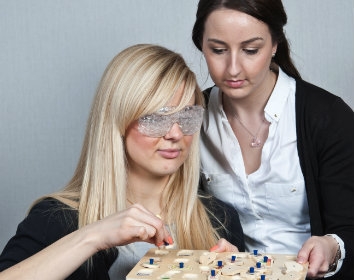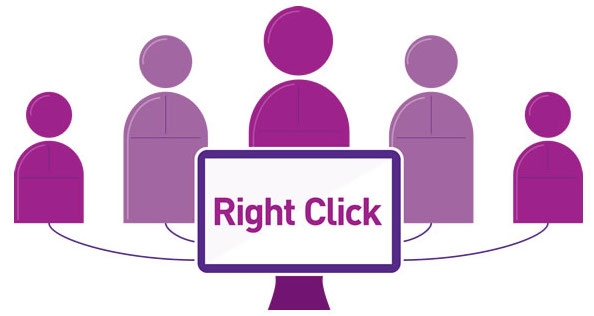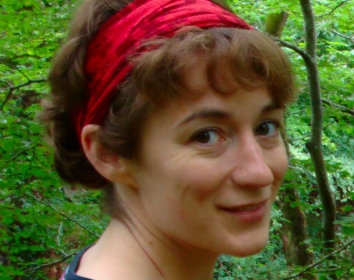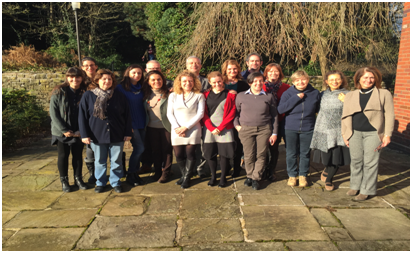Building Bridges to Vision - Partnership Working on Autism and Sight Loss
Joe Long
Would you know how to detect sight loss or visual difficulties in someone with autism? That question might be particularly hard to answer if that someone is unable to communicate their daily experiences verbally, displays repetitive gestures, or whose reaction to their environments is usually put down to‘their autism’. But it is a question that Scottish Autism’s practitioners are becoming better equipped to answer in the affirmative.
Since 2013 Scottish Autism and the RNIB (Royal National Institute of Blind People) have been working in partnership to raise awareness of sight loss and vision issues among our staff teams. Previous research on vision problems shows that those with sight loss often present behaviour similar to those with autism*. These may include stereotyped and repetitive behaviours such as eye flicking, rocking or gazing at light as well as linguistic features like echolalia.
Research has also shown that sight loss is often undetected in people with complex needs**and so autism support services need to be particularly alert to potential visual impairment. A person’s quality of life can be severely impaired by undiagnosed sight loss and if an eye conditionis not diagnosed a person may lose further sight.
The RNIB’s ‘Bridge to Vision’ training programme has been developed to provide practitioners in a range of fields – from dementia care to learning disability services – with the skills to detect potential signs of sight loss. It involves two stages: first, vision awareness training for a large number of staff and second, the recruitment of ‘Vision Champions’within our services. During this project 57 staff in Central Area, Fife and Tayside, and New Struan School undertook vision awareness training. Participants learned about the functioning of the eye, common vision problems andundertook a series of exercises that simulated different eye conditions. This experiential learning proved very powerful for staff in understanding what it might be like to have impaired vision. As one practitioner told researchers: “A lot of the guys we work with, it makes you appreciate just how difficult their day-to-day life is.”
"A lot of the guys we work with, it makes you appreciate just how difficult their day-to-day life is." Support Worker
A core part of the training was also recognising signs of sight loss that may present as autistic behaviour. As one practitioner told researchers: “a lot of the stuff we weretaught is very similar to what we for years have been putting down to somebody’s autism”. The training has really got practitioners thinking about what might lie behind certain presentations – walking warily across zebra crossings or stairs, standing very close to staff, or disliking laminated communication aids. Someone we support may look away during communication and this may be a characteristic of autism, but this may also be a sign of macular disease. This is not to say that everybody displaying particular behavioursh as a sight loss issue, but it gives practitioners some warning signs to look out for. These signs can then prompt an optometry referral and sight test so that sight loss can be ruled in or out. As one Autism Practitioner summarised to me: “This won’t make a difference to everyone we work with, but for those it does it will make all the difference.”
"A lot of the stuff we were taught is very similar to what we for years have been putting down to somebody’s autism." Support Worker
As well as improving detection of sight loss, practitioners have learned some changes that they can make to their practice and to their service environments in order to make life easier for those with sight loss. One Vision Champion explained: “even if there is an eyesight problem and they wear glasses, there’s stuff that we could do to the environment that would make things better.” Project participants have reported homes being repainted, handrails being installed, and practitioners learning to approach people they support in different ways.
"Even if there is an eyesight problem and they wear glasses, there's stuff that we could do to the environment that would make things better." Autism Practitioner
Much of this work has been led by our Vision Champions. These six support practitioners undertook an advanced level of training that has enabled them to make detailed observations where there is a suspicion of sight loss. The team use an established RNIB toolkit to enable detailed referrals to optometry. Our Vision Champions have also audited the visual information in our support plans and have made recommendations for the improvement of vision information in service documents.
The impact of this training has been tracked by a research team that includes colleagues from Edinburgh Napier University as well as RNIB and Scottish Autism. The team have undertaken surveys and focus groups to capture the experiences of staff that have taken part in the programme.
The research, to be published later this year, will show that not only are practitioners better equipped to notice sight loss, but more confident in making referrals and adjusting environments. As well as demonstrating the increased skills of practitioners, the data shows where we can do more as organisations to support the work of Vision Champions, and where we need to work with optometry professionals in order to ensure that there are autism friendly pathways to eye care available in Scotland.
Most importantly, the question that opened this article is one we have asked of practitioners before and after the ‘Bridge to Vision’ training and the answer is increasingly a clear ‘yes’. Our relationship with RNIB has been a positive and enriching one as we have learned more about vision issues, our colleagues have also learned from our practitioners about the practicalities of working with autism. The relationship is set to continue as we ensure that those we support have access to appropriate eye care and that has surely been a bridge worth building.
REFERENCES
* See: Hobson, R. P., A. Lee, et al. (1999) “Autism and congenital blindness.” Journal of Autism Dev Disorder 29(1): 45-56.
Kaplan, M., B. Rimland, et al. (1999) “Strabismus in Autism Spectrum Disorder.” Focus on Autism and Other Developmental Disabilities 14: 101-105.
Scharre, J. E. and M. P. Creedon (1992) “Assessment of Visual Function in Autistic Children.” Optometry and Vision Science 69(6): 433-439.
Turner, M. (1999) “Annotation: Repetitive Behaviour in Autism: A review of Psychological Research.” Journal of Child Psychology and Psychiatry 40(6): 839-849.
** See: Emerson, E. and J. Robertson (2011) The Estimate Prevalence of Visual Impairment among People with Learning Disabilities in the UK. Improving Health & Lives: Learning Disabilities Observatory.
van Splunder, J., J. S. Stilma, et al. (2006) “Prevalence of visual impairments in adults with intellectual disabilities in the Netherlands: cross-sectional study.” Eye 20: 1004-1010.
RESOURCES AND LINKS
For more information please visit the RNIB website:
www.rnib.org.uk/services-we-offer/learning-disability-services





